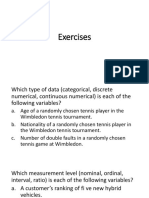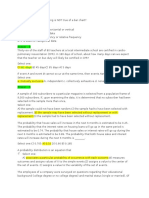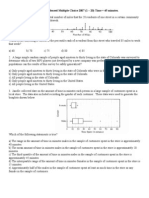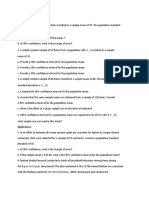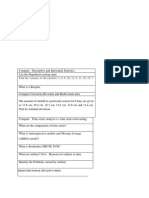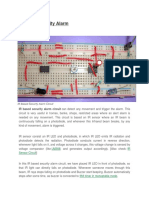0 ratings0% found this document useful (0 votes)
146 viewsExercises 3
Exercises 3
Uploaded by
The FacesThe document contains a series of exercises involving statistical concepts such as types of variables, measurement levels, samples, distributions, probabilities, confidence intervals, hypothesis testing, ANOVA, and regression. Learners are asked to identify variable types and measurement levels, perform statistical procedures like creating plots and distributions, calculate probabilities and percentages, conduct hypothesis tests and interpret results. The goal is for learners to demonstrate their understanding of foundational statistical concepts and skills.
Copyright:
© All Rights Reserved
Available Formats
Download as PPTX, PDF, TXT or read online from Scribd
Exercises 3
Exercises 3
Uploaded by
The Faces0 ratings0% found this document useful (0 votes)
146 views20 pagesThe document contains a series of exercises involving statistical concepts such as types of variables, measurement levels, samples, distributions, probabilities, confidence intervals, hypothesis testing, ANOVA, and regression. Learners are asked to identify variable types and measurement levels, perform statistical procedures like creating plots and distributions, calculate probabilities and percentages, conduct hypothesis tests and interpret results. The goal is for learners to demonstrate their understanding of foundational statistical concepts and skills.
Copyright
© © All Rights Reserved
Available Formats
PPTX, PDF, TXT or read online from Scribd
Share this document
Did you find this document useful?
Is this content inappropriate?
The document contains a series of exercises involving statistical concepts such as types of variables, measurement levels, samples, distributions, probabilities, confidence intervals, hypothesis testing, ANOVA, and regression. Learners are asked to identify variable types and measurement levels, perform statistical procedures like creating plots and distributions, calculate probabilities and percentages, conduct hypothesis tests and interpret results. The goal is for learners to demonstrate their understanding of foundational statistical concepts and skills.
Copyright:
© All Rights Reserved
Available Formats
Download as PPTX, PDF, TXT or read online from Scribd
Download as pptx, pdf, or txt
0 ratings0% found this document useful (0 votes)
146 views20 pagesExercises 3
Exercises 3
Uploaded by
The FacesThe document contains a series of exercises involving statistical concepts such as types of variables, measurement levels, samples, distributions, probabilities, confidence intervals, hypothesis testing, ANOVA, and regression. Learners are asked to identify variable types and measurement levels, perform statistical procedures like creating plots and distributions, calculate probabilities and percentages, conduct hypothesis tests and interpret results. The goal is for learners to demonstrate their understanding of foundational statistical concepts and skills.
Copyright:
© All Rights Reserved
Available Formats
Download as PPTX, PDF, TXT or read online from Scribd
Download as pptx, pdf, or txt
You are on page 1of 20
Exercises
Which type of data (categorical, discrete
numerical, continuous numerical) is each of the
following variables?
a. Age of a randomly chosen tennis player in the
Wimbledon tennis tournament.
b. Nationality of a randomly chosen tennis player in
the Wimbledon tennis tournament.
c. Number of double faults in a randomly chosen
tennis game at Wimbledon.
Which measurement level (nominal, ordinal,
interval, ratio) is each of the following variables?
a. A customer’s ranking of fi ve new hybrid
vehicles.
b. Noise level 100 meters from the Dan Ryan
Expressway at a randomly chosen moment.
c. Number of occupants in a randomly chosen
commuter vehicle on the San Diego Freeway.
There are 327 official ports of entry in the United
States. The Department of Homeland Security
selects 15 ports of entry at random to be audited
for compliance with screening procedures of
incoming travelers through the primary and
secondary vehicle and pedestrian lanes. What
kind of sample is this (simple random, systematic,
stratifi ed, cluster)?
The durations (minutes) of 26 electric power
outages in the community of Sonando Heights
over the past five years are shown below.
(a) Duration Prepare a stem-and-leaf plot.
(b) Prepare a dot plot.
(c) Prepare a frequency distribution and
histogram.
(d) Describe the distribution, based on these
displays.
Data file: Duration
Revenue and Net Income (millions) for 27 Randomly
Chosen Fortune 1000 Companies.
(a) Use Excel to make a scatter plot, placing Revenue
on the X-axis and Net Income on the Y-axis. Add
titles and modify the default colors, fonts, etc., as
you judge appropriate to make the scatter plot
effective.
(b) Describe the relationship (if any) between X and Y.
Weak? Strong? Negative? Positive? Linear?
Nonlinear?
Data file: RevenueIncome
The table below shows average daily sales of Rice
Krispies in the month of June in 74 Noodles &
Company restaurants.
(a) Make a histogram for the data.
(b) Would you say the distribution is skewed?
(c) Calculate the mean and standard deviation.
(d) Are there any outliers?
Data file: RiceKrispies
Analysis of annualized returns over a 10-year
period showed that prepaid tuition plans had a
mean return of 6.3 percent with a standard
deviation of 2.7 percent, while the Standard &
Poor’s 500 stock index had a mean return of 12.9
percent with a standard deviation of 15.8 percent.
(a) Calculate and compare the coefficients of
variation.
(b) Why would we use a coefficient of variation?
Why not just compare the standard deviations?
Analysis of annualized returns over a 10-year
period showed that prepaid tuition plans had a
mean return of 6.3 percent with a standard
deviation of 2.7 percent, while the Standard &
Poor’s 500 stock index had a mean return of 12.9
percent with a standard deviation of 15.8 percent.
(a) Calculate and compare the coefficients of
variation.
(b) Why would we use a coefficient of variation?
Why not just compare the standard deviations?
The contingency table below shows the results of a survey of
online video viewing by age. Find the following probabilities or
percentages:
a. Probability that a viewer is aged 18–34.
b. Probability that a viewer prefers watching TV videos.
c. Percentage of viewers who are 18–34 and prefer watching
user-created videos.
d. Percentage of viewers aged 18–34 who prefer watching
user-created videos.
e. Percentage of viewers who are 35–54 or prefer user
created-videos.
In the last 50 years, the average number of deaths
due to alligators in Florida is 0.3 death per year.
Assuming no change in this average, in a given
year find the probability of
(a) no alligator deaths;
(b) (b) at least 2 alligator deaths.
The diameter of bushings turned out by a
manufacturing process is a normally distributed
random variable with a mean of 4.035 mm and a
standard deviation of 0.005 mm. A sample of 25
bushings is taken once an hour.
(a) Within what interval should 95 percent of the b
ushing diameters fall?
(b) Within what interval should 95 percent of the
sample means fall?
(c) What conclusion would you reach if you saw a
sample mean of 4.020? A sample mean of 4.055?
A poll of 125 college students who watch The Big
Bang Theory showed that 83 of them usually
watch on a mobile device (e.g., laptop).
(a) Assuming that this was a random sample,
construct a 90 percent confidence interval for
the proportion of all college students who
usually watch this show on a mobile device.
(b) Would a finite population correction be
required? Explain.
To encourage telephone efficiency, a catalog call
center issues a guideline that at least half of all
telephone orders should be completed within 2
minutes. Subsequently, a random sample of 64
telephone calls showed that only 24 calls lasted 2
minutes or less.
(a) At α 5 .05 is this a significant departure from
the guideline in a left-tailed test? State your
hypotheses and decision rule.
(b) Find the p-value.
An experimental surgical procedure is being studied as
an alternative to the old method. Both methods are
considered safe. Five surgeons perform the operation
on two patients matched by age, sex, and other
relevant factors, with the results shown. The time to
complete the surgery (in minutes) is recorded.
(a) At the 5 percent significance level, is the new way
faster? State your hypotheses and show all steps
clearly.
(b) Is the decision close?
Data file: Surgery
In 2006, a sample of 200 in-store shoppers
showed that 42 paid by debit card. In 2009, a
sample of the same size showed that 62 paid by
debit card.
(a) Formulate appropriate hypotheses to test
whether the percentage of debit card
shoppers increased.
(b) Carry out the test at α 5 .01.
(c) Find the p-value.
The XYZ Corporation is interested in possible
differences in days worked by salaried employees
in three departments in the financial area. A
survey of 23 randomly chosen employees reveals
the data shown below. Because of the casual
sampling methodology in this survey, the sample
sizes are unequal.
Research question: Are the mean annual
attendance rates the same for employees in these
three departments?
Data file: DaysWorked
Several friends go bowling several times per month. They keep track
of their scores over several months. An ANOVA was performed.
(a) What kind of ANOVA is this (one-factor, two-factor, etc.)?
(b) How many friends were there? How many months were
observed? How many observations per bowler per month?
Explain how you know.
(c) At α 5 .01, what are your conclusions about bowling scores?
Explain, referring either to the F tests or p-values.
In the following regression, X = weekly pay, Y = income tax
withheld, and n = 35 McDonald’s employees.
(a) Write the fitted regression equation.
(b) State the degrees of freedom for a two-tailed test for
zero slope, and use Appendix D to find the critical
value at α 5 .05.
(c) What is your conclusion about the slope?
(d) Interpret the 95 percent confidence limits for the
slope.
(e) Verify that F = t2 for the slope.
(f) In your own words, describe the fit of this regression.
You might also like
- Ap Stats CH 6 TestDocument6 pagesAp Stats CH 6 Testapi-2535798530% (1)
- Homework Assignment-1Document4 pagesHomework Assignment-1John Depasquale0% (1)
- Statistical Reasoning For Everyday Life 5th Edition Bennett Briggs Triola Test BankDocument10 pagesStatistical Reasoning For Everyday Life 5th Edition Bennett Briggs Triola Test Bankevelyn100% (27)
- Exercises 3Document20 pagesExercises 3Thành ĐạtNo ratings yet
- BA301 Ch03 QuizDocument8 pagesBA301 Ch03 QuizwaysNo ratings yet
- Multiple Choice Questions Business StatisticsDocument60 pagesMultiple Choice Questions Business StatisticsChinmay Sirasiya (che3kuu)No ratings yet
- Prob & Stat (1) - 1Document7 pagesProb & Stat (1) - 1girmaw720No ratings yet
- Chapter 3 Numerical Descriptive MeasuresDocument7 pagesChapter 3 Numerical Descriptive MeasuresKultum DemieNo ratings yet
- ExerciseDocument10 pagesExerciseNguyen Mai QuynhNo ratings yet
- DeVry MATH 533 Final Exam 100% Correct AnswerDocument6 pagesDeVry MATH 533 Final Exam 100% Correct AnswerDeVryHelp100% (1)
- S TATISTICSDocument8 pagesS TATISTICSRussiel DagohoyNo ratings yet
- DeVry MATH 533 Final ExamDocument6 pagesDeVry MATH 533 Final ExamdevryfinalexamscomNo ratings yet
- Latihan Soal StatistikaDocument14 pagesLatihan Soal StatistikaArgantha Bima WisesaNo ratings yet
- Past Exam 1Document6 pagesPast Exam 1Stan DitonaNo ratings yet
- Assigment (1&2) Statistical Methods (1551) PDF - Docx (21-06-2018) PDFDocument6 pagesAssigment (1&2) Statistical Methods (1551) PDF - Docx (21-06-2018) PDFMaria AsgharNo ratings yet
- SB MidtermDocument21 pagesSB MidtermBùi Nguyễn Hải GiangNo ratings yet
- Lind17e Chapter03 TBDocument11 pagesLind17e Chapter03 TBdockmom4No ratings yet
- Mas202 - 2022Document53 pagesMas202 - 2022huytqss180010No ratings yet
- Statistical Inference Assignment 3Document9 pagesStatistical Inference Assignment 3Shayan ShamsiNo ratings yet
- Test Bank For Statistical Reasoning For Everyday Life 5th Edition Bennett Briggs Triola 9780134494043Document36 pagesTest Bank For Statistical Reasoning For Everyday Life 5th Edition Bennett Briggs Triola 9780134494043DavidMaciasgtkiz100% (33)
- Bmgt230 Exam 1Document11 pagesBmgt230 Exam 1Nathan YehNo ratings yet
- Study Resources For Test Bank For Essentials of Statistics, 4/E 4th Edition: 0321761715Document30 pagesStudy Resources For Test Bank For Essentials of Statistics, 4/E 4th Edition: 0321761715fimanumero100% (4)
- Stats Medic - Diagnostic TestDocument21 pagesStats Medic - Diagnostic TestAustin StoddardNo ratings yet
- Sample Mid-Term Exam (The Sample Contains Only 20 Questions)Document5 pagesSample Mid-Term Exam (The Sample Contains Only 20 Questions)Phan Huỳnh Châu Trân100% (1)
- Ex Week 1Document4 pagesEx Week 1huyNo ratings yet
- 02 Unit 3A FRQ Classical Probability Video ReviewDocument2 pages02 Unit 3A FRQ Classical Probability Video Reviewdario.dsNo ratings yet
- Final Exam Fall 2022 - Paper 3 (Quesitons and Answers)Document20 pagesFinal Exam Fall 2022 - Paper 3 (Quesitons and Answers)dungnhse180163No ratings yet
- Mid Term Examination Statistic For Management Exam BDocument2 pagesMid Term Examination Statistic For Management Exam BliaNo ratings yet
- Mini-Test: Chapter 1 & 2 Student's name: Nguyễn Quỳnh DươngDocument1 pageMini-Test: Chapter 1 & 2 Student's name: Nguyễn Quỳnh DươngDuong Nguyen QuynhNo ratings yet
- MTH302 Solved MCQs Mega FileDocument34 pagesMTH302 Solved MCQs Mega Filemuqadasnisar70No ratings yet
- Mathematics in Quality ManagementDocument6 pagesMathematics in Quality ManagementvishvajitjNo ratings yet
- AS Exercise 2021Document61 pagesAS Exercise 2021Pik ki WongNo ratings yet
- EXTRA EXERCISE - Chapter 1 (Section1.1-1.2)Document3 pagesEXTRA EXERCISE - Chapter 1 (Section1.1-1.2)desidivamyNo ratings yet
- Week 1-Intro To StatisticsDocument6 pagesWeek 1-Intro To StatisticswendyNo ratings yet
- QNT 561 Final Exam Question With AnswersDocument10 pagesQNT 561 Final Exam Question With AnswersassignmentsehelpNo ratings yet
- 2007 Stat Released MC 1 To 20Document7 pages2007 Stat Released MC 1 To 20Shelbie ShelderNo ratings yet
- Question of Chapter 8 StaticsDocument7 pagesQuestion of Chapter 8 Staticsحمزہ قاسم کاھلوں جٹ0% (1)
- Tutorial 01 PASDocument4 pagesTutorial 01 PASWinnie NguyễnNo ratings yet
- Mid Term 1 Practice Packet vs2Document15 pagesMid Term 1 Practice Packet vs2Kayanna HallNo ratings yet
- Mock Exam Midterm Statistics IDocument24 pagesMock Exam Midterm Statistics IDelia MunteanuNo ratings yet
- Estatistica Multipla EscolhaDocument20 pagesEstatistica Multipla EscolhadrinakanoNo ratings yet
- Notes 2Document51 pagesNotes 2eph0% (1)
- Access Test Bank for Statistical Reasoning for Everyday Life 5th Edition Bennett Briggs Triola 9780134494043 All Chapters Immediate PDF DownloadDocument36 pagesAccess Test Bank for Statistical Reasoning for Everyday Life 5th Edition Bennett Briggs Triola 9780134494043 All Chapters Immediate PDF Downloadgengonkuzo100% (7)
- MPM 68 Individual 2 Assign 1Document4 pagesMPM 68 Individual 2 Assign 1eyob yohannes100% (1)
- National University of Lesotho Department of Statistics and Demography St1311 - Introduction To Statistics 1 - Tutorial 1Document5 pagesNational University of Lesotho Department of Statistics and Demography St1311 - Introduction To Statistics 1 - Tutorial 1Tsitsi KarimakwendaNo ratings yet
- Tutorial 1-14 Student S Copy 201605Document27 pagesTutorial 1-14 Student S Copy 201605文祥0% (2)
- Statistical Methods For Decision MakingDocument6 pagesStatistical Methods For Decision MakingjegadeeswariganapathyNo ratings yet
- Statistics FinalReviewDocument8 pagesStatistics FinalReviewGaneshNo ratings yet
- Quantative Analysis-1 Sample PaperDocument4 pagesQuantative Analysis-1 Sample Paperghogharivipul100% (1)
- Chapter - 7: Sampling Distribution: Calculation of Point EstimatorsDocument2 pagesChapter - 7: Sampling Distribution: Calculation of Point EstimatorsNitish Nair0% (1)
- QB For ADSDocument12 pagesQB For ADSKunj TrivediNo ratings yet
- PrelimDocument3 pagesPrelimJohn AlbertNo ratings yet
- BM-707 & BM-607 MID AssignmentDocument4 pagesBM-707 & BM-607 MID AssignmentNoumanQasmiNo ratings yet
- StatisticsDocument2 pagesStatisticsnguyenanhanh250705No ratings yet
- Test Bank For Statistical Reasoning For Everyday Life 4th Edition Bennett Briggs Triola 0321817621 9780321817624Document36 pagesTest Bank For Statistical Reasoning For Everyday Life 4th Edition Bennett Briggs Triola 0321817621 9780321817624DavidMaciasgtkiz100% (25)
- BUS 511-Midterm-Test - 1-SampleQuestionsDocument3 pagesBUS 511-Midterm-Test - 1-SampleQuestionshod.mechengineerNo ratings yet
- Assignment #3Document9 pagesAssignment #3Imen Ksouri100% (1)
- AP Statistics Flashcards, Fifth Edition: Up-to-Date PracticeFrom EverandAP Statistics Flashcards, Fifth Edition: Up-to-Date PracticeNo ratings yet
- Revise Mid TermDocument43 pagesRevise Mid TermThe FacesNo ratings yet
- Revision On Managerial Accounting: by Isb Academic TeamDocument99 pagesRevision On Managerial Accounting: by Isb Academic TeamThe FacesNo ratings yet
- Mat102 - Statistics For Business - S2-2019Document14 pagesMat102 - Statistics For Business - S2-2019The FacesNo ratings yet
- Factors Influencing Purchase Intention of Starbucks PDFDocument142 pagesFactors Influencing Purchase Intention of Starbucks PDFThe FacesNo ratings yet
- Research Proposal ExampleDocument24 pagesResearch Proposal ExampleThe FacesNo ratings yet
- Starbucks Corporation Annual Report 2020: Form 10-K (NASDAQ:SBUX)Document10 pagesStarbucks Corporation Annual Report 2020: Form 10-K (NASDAQ:SBUX)The FacesNo ratings yet
- Aoyue Int2738Document6 pagesAoyue Int2738trabajo728No ratings yet
- Primaries AvatarDocument7 pagesPrimaries Avatarrholzhauser01100% (1)
- RTP MIL LAS Q3 Wk4 MELC4Document6 pagesRTP MIL LAS Q3 Wk4 MELC4Mikhaila FernandezNo ratings yet
- Instant download Programming in Lua 2nd Edition pdf all chapterDocument20 pagesInstant download Programming in Lua 2nd Edition pdf all chaptermudgiltorsin100% (1)
- Wayne CVDocument13 pagesWayne CVapi-286085331No ratings yet
- IR Based Security AlarmDocument4 pagesIR Based Security AlarmManjeet SinghNo ratings yet
- Gap Analysis Deadline: May 26Document3 pagesGap Analysis Deadline: May 26Karla Therese Licos100% (3)
- Connective TissuesDocument4 pagesConnective TissuesLAKHASTH JAYASILANNo ratings yet
- The History of EvolutionDocument2 pagesThe History of EvolutionZen ChenNo ratings yet
- Divergence Theorem of Gauss-Lec-6Document9 pagesDivergence Theorem of Gauss-Lec-6aryanNo ratings yet
- Discipline S: Quarter Iii - Lesson IIIDocument19 pagesDiscipline S: Quarter Iii - Lesson IIIShyra PapaNo ratings yet
- Software Requirements Specification: Version 1.0 ApprovedDocument13 pagesSoftware Requirements Specification: Version 1.0 ApprovedNasrullah KhanNo ratings yet
- 1st Year Physics Halfyearly Important QuestionsDocument3 pages1st Year Physics Halfyearly Important QuestionsmohiuddinmanzoorsyedNo ratings yet
- 75 Hard ChallengeDocument1 page75 Hard Challengemajoratul123No ratings yet
- Caparo Price List No.12 1st Jan 2022Document24 pagesCaparo Price List No.12 1st Jan 2022Sanjay Kumar BansalNo ratings yet
- Proceedings HM 2014Document751 pagesProceedings HM 2014goranb87No ratings yet
- Instant Download Electrochemical Biosensors Ali A. Ensafi PDF All ChaptersDocument41 pagesInstant Download Electrochemical Biosensors Ali A. Ensafi PDF All Chapterslabbygrown8x100% (2)
- Imo Status of ConventionsDocument24 pagesImo Status of Conventionsgeims11No ratings yet
- PowertrainDocument13 pagesPowertrainso.sorrounding factNo ratings yet
- Company Law Study Material FinalDocument183 pagesCompany Law Study Material Finalshivam_2607No ratings yet
- Dyslipidemia: Darmono SSDocument35 pagesDyslipidemia: Darmono SSLa Ode Rinaldi0% (1)
- Stop TB Program - Envisioning A Tuberculosis Free World, The Goal of TheDocument4 pagesStop TB Program - Envisioning A Tuberculosis Free World, The Goal of TheCharles Mart Rabe-Rodriguez HortilanoNo ratings yet
- IMO2008 - MSC267 (85) - 2008 IS Code PDFDocument94 pagesIMO2008 - MSC267 (85) - 2008 IS Code PDFSrikanth ShivramNo ratings yet
- Management TraineesDocument2 pagesManagement TraineesSubrahmanya G M Bhat100% (1)
- Easa Pad 22-015 1Document3 pagesEasa Pad 22-015 12344321No ratings yet
- Loudon Ch. 5 Review: Alkene Reactions: Jacquie Richardson, CU Boulder - Last Updated 2/25/2015Document8 pagesLoudon Ch. 5 Review: Alkene Reactions: Jacquie Richardson, CU Boulder - Last Updated 2/25/2015J31415No ratings yet
- Module No 3 Aircraft Leasing & FinanceDocument8 pagesModule No 3 Aircraft Leasing & Financeshaik akhilNo ratings yet
- Mewp Operating InstrDocument4 pagesMewp Operating InstrPrimelift Safety Resources LimitedNo ratings yet
- Peter and The Wolf Study GuideDocument19 pagesPeter and The Wolf Study GuideDalila Vicente100% (1)
- COMMISSIONER OF INCOME TAX V H.GDocument2 pagesCOMMISSIONER OF INCOME TAX V H.GroshaniNo ratings yet



